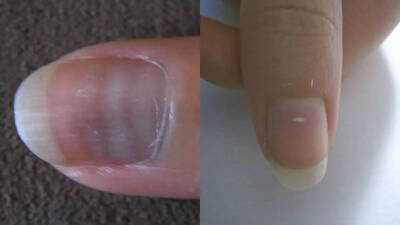White lines on nails could signal liver, kidney, or heart problems: Know the types

White lines on nails , medically referred to as leukonychia , are a common occurrence and are usually harmless. These lines can appear as small spots, horizontal bands, or lengthwise streaks, often resulting from minor trauma to the nail matrix. However, in some cases, they may indicate underlying health issues such as nutritional deficiencies, liver or kidney problems, or exposure to toxins. Certain patterns, such as Muehrcke’s or Mees’ lines, can suggest systemic conditions that require medical attention. Recognising the type and pattern of white lines, along with accompanying symptoms, is essential for understanding their significance and deciding if professional evaluation is necessary.
Types of white lines on nails that indicate serious health issues
1. Leukonychia punctata (White spots)
These are small, white spots or dots that commonly appear on the nails. The most frequent cause is minor trauma or injury to the nail matrix, such as bumping or pressing the nail. Nutritional deficiencies, particularly zinc or calcium deficiency, may also contribute in some cases. These spots usually grow out with the nail over time and are generally harmless. Persistent or widespread spotting, however, may indicate underlying health issues such as systemic infections or metabolic disturbances.
2. Muehrcke's lines
Muehrcke's lines appear as paired, smooth, white bands running parallel to the lunula (the crescent-shaped area at the base of the nail). Unlike other white lines, these do not move with nail growth because they reflect changes in the nail bed rather than the nail plate itself. They are often associated with hypoalbuminaemia (low levels of albumin in the blood), which can result from liver disease, kidney disease, or malnutrition. Monitoring these lines can be important, as they may indicate serious systemic conditions requiring medical attention.
3. Mees' lines
Mees' lines are transverse white bands that move outward as the nail grows. They are often linked to systemic illnesses, including arsenic or heavy metal poisoning, chemotherapy, or severe infections. Because these lines track with nail growth, their position can help approximate the timing of the causative event. Mees’ lines may appear on multiple nails simultaneously and can sometimes be mistaken for other nail abnormalities, so accurate diagnosis is crucial.
4. Longitudinal leukonychia
Longitudinal leukonychia presents as white lines running lengthwise along the nail, sometimes covering a significant portion of the nail plate. According to a study published in the
American Journal of Clinical Dermatology, this condition can be hereditary and is often associated with genetic disorders such as Darier’s disease, Hailey-Hailey disease, or other keratinisation disorders. In some cases, longitudinal leukonychia may also result from repeated trauma or chronic exposure to chemicals.
5. Terry’s nails
Terry’s nails appear mostly white with a narrow band of pink or brown at the tip of the nail. A study published in
PMC shows this condition is frequently linked to ageing but can also indicate liver disease, congestive heart failure, or diabetes. The white appearance is due to changes in the nail bed, and unlike Mees’ or Muehrcke’s lines, it does not move with nail growth.
6. Lindsay’s nails (Half-and-half nails)
These nails show a distinct colour separation, with the proximal portion appearing white and the distal portion reddish-brown. According to a study published in
PMC, they are commonly associated with chronic kidney disease and may provide an early clue to renal dysfunction. The exact mechanism involves changes in the nail bed vasculature and pigmentation.
Common triggers and factors
Certain environmental or lifestyle factors can worsen or trigger white lines:
- Frequent exposure to harsh chemicals or detergents
- Nail biting or trauma
- Poor diet lacking essential nutrients
- Stress or chronic illness
- Certain medications or supplements
Home remedies and nail care tips
While underlying medical conditions require professional treatment, simple home care can help maintain nail health :
- Moisturise regularly: Use cuticle oils or creams to strengthen nails.
- Protect nails: Wear gloves while cleaning or handling chemicals.
- Balanced diet: Include foods rich in protein, zinc, iron, and vitamins A, C, and D.
- Avoid trauma: Be gentle while trimming nails and avoid biting.
- Stay hydrated: Proper hydration supports overall nail health.
Disclaimer: This article is for informational purposes only and does not constitute medical advice. Always consult a qualified healthcare professional before making any changes to your health routine or treatment.
 White lines on nails , medically referred to as leukonychia , are a common occurrence and are usually harmless. These lines can appear as small spots, horizontal bands, or lengthwise streaks, often resulting from minor trauma to the nail matrix. However, in some cases, they may indicate underlying health issues such as nutritional deficiencies, liver or kidney problems, or exposure to toxins. Certain patterns, such as Muehrcke’s or Mees’ lines, can suggest systemic conditions that require medical attention. Recognising the type and pattern of white lines, along with accompanying symptoms, is essential for understanding their significance and deciding if professional evaluation is necessary.
White lines on nails , medically referred to as leukonychia , are a common occurrence and are usually harmless. These lines can appear as small spots, horizontal bands, or lengthwise streaks, often resulting from minor trauma to the nail matrix. However, in some cases, they may indicate underlying health issues such as nutritional deficiencies, liver or kidney problems, or exposure to toxins. Certain patterns, such as Muehrcke’s or Mees’ lines, can suggest systemic conditions that require medical attention. Recognising the type and pattern of white lines, along with accompanying symptoms, is essential for understanding their significance and deciding if professional evaluation is necessary.